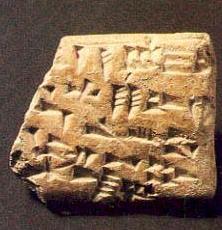For 40 years Claude Schaeffer directed excavations at Ras Shamra in Syria. There he and his colleagues uncovered the remains of the long lost city of Ugarit, a Late Bronze Age metropolis in early Biblical times. And among the ruins of Ugarit, he found the archives of the ancient city The clay tablets discovered in those archives have had a revolutionary impact on the study of the Hebrew Bible.
It was on May 14, 1929, as the dirt was being cleared from the floor of what had once been a building (a library, as they were later to determine), that the first clay tablets were found. The tablets were provisionally dated on the basis of other objects found in the surrounding excavations. The texts, together with their written substance, appeared to come from the 14th to 13th centuries B.C.
No doubt Schaeffer was thrilled to have discovered ancient texts as well as artifacts. Yet the real significance of the texts did not become evident until the writing was examined in detail. Schaeffer himself was an archaeologist, not a linguist; he entrusted the examination of the texts to Charles Virolleaud, the local director of the Bureau of Antiquities, who was skilled in the ancient languages and scripts of the area. As Virolleaud examined the tablets, he recognized immediately that he was faced with a significant discovery. The tablets contained cuneiform writing, which was known well enough from the multitude of texts recovered from other excavations. But the writing on these texts from Ras Shamra was entirely different from any of the other forms of cuneiform Virolleaud had ever seen. Instead of the several hundred different symbols typical of the normal syllabic cuneiform script, these newly discovered tablets contained fewer than 30 distinct symbols. It appeared, in other words, that the tablets contained writing in a kind of cuneiform alphabet.
After determining the apparently alphabetic character of the writing, Virolleaud then faced the daunting task of deciphering the script. He was able to make only a little progress in the first weeks, but as a service to scholars, he published the texts, providing photographs and copies of the inscriptions for examination by his colleagues. The most remarkable part in the story of the decipherment was played by Hans Bauer, who received a copy of Virolleaud’s photographs and transcriptions on April 22, 1930.
Bauer brought an extraordinary background to his role as decipherer. Then 51, he was Professor of Oriental Languages in the German University of Halle. He was multilingual, having mastered some East Asian languages in addition to the Semitic languages. But perhaps his most important skill had been honed during service in the German armed forces in World War I. He had been engaged in cryptanalysis, or code-breaking, for German intelligence. That experience had taught him the value of using a statistical method to crack codes. Five days after receiving copies of the texts, Bauer succeeded in assigning phonetic values to 20 of the cuneiform symbols, or about 80 percent of the signs used on the tablets. His work was refined and corrected in some details by others; Édouard Dhorme in Jerusalem and Virolleaud in Latakia put the finishing touches to Bauer’s decipherment. From the summer of 1930, the clay tablets recovered from Ras Shamra by Schaeffer’s team could be translated and read.
Although ancient Ugarit and its archives have had an important impact on various disciplines, none has been so profoundly affected as Biblical studies.
The archives are written in half a dozen different languages and a variety of scripts. The texts that took the limelight, however, were those in the formerly unknown alphabetic cuneiform. The language underlying this script is called Ugaritic, after the ancient city in which it was used, although the script has now been found at a number of sites as far south as Tel Aphek near Tel Aviv. Ugaritic is a Northwest Semitic language and a close linguistic relative of Biblical Hebrew. The archives of Ras Shamra have yielded several thousand tablets, including 1,400 texts in the Ugaritic language and scripta; while many are fragmentary, others have been preserved in excellent condition. Larger archives have been found, such as the 12,000–15,000 tablets recently discovered at Ebla, but the Ugarit archives are nevertheless a very significant corpus of texts. The importance of the texts for Biblical studies emerges not only from the close relationship in language but also from the substance and the literary forms common to both bodies of literature.
The Ugaritic texts are unusually diverse. Many are typical of texts found in state archives—administrative texts, census lists, economic texts, and letters.
Other tablets are even more interesting because they are poetic in form and literary in character. The splendid legends of Keret and of Aqhat reflect a panorama on life and religion in the ancient world of Syria. Mythological tablets concerning the god Baal provide new insight into the beliefs concerning this deity whose name occurs so frequently in the Hebrew Bible. There are other texts, of a more ritual character, which illuminate the daily practice of religion in ancient Ugarit.
Excerpted from The Tablets from Ugarit and Their Importance for Biblical Studies, Peter C. Craigie, BAR 9-05, Sep-Oct 1983.
